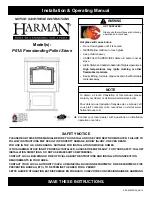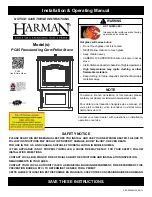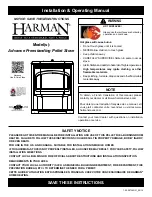
Deco Installation and Operation Manual
25
you place it. Leave the gasket about 1/2” long when you cut it and press the end into the
groove. Tuck any loose fibres under the gasket and into the silicone. Close the door and
do not use the stove for 24 hours.
5.1.4 Replacing the Glass Gasket and/or the Glass
It is a good idea to replace the glass gasket when the door gasket is replaced. The gasket
is flat, adhesive-backed, woven fibreglass. Remove the glass retaining screws and clips.
Lift out the glass and pull off the old gasket. This is a good time to clean the glass
thoroughly.
The gasket must be centred on the edge of the glass. To do this easily, peel back a
section of the paper covering the adhesive and place the gasket on a table with the
adhesive side up. Stick the end of the gasket to the middle of one edge, then press the
edge of the glass down onto the gasket, taking care that it is perfectly centred on the
gasket. Peel off more of the backing and rotate the glass and press the next section onto
the gasket. Do not stretch the gasket as you place it. Continue until you get to the start and
trim the gasket to length. Now pinch the gasket to the glass in a U shape, all around the
glass. Reinstall the glass, being careful to centre the glass carefully in the door. Do not
over-tighten the screws. Note that the two main causes of broken door glass are uneven
placement in the door and over-tightening of retaining screws.
Do not abuse the glass door by striking or slamming shut. Do not use the stove if the glass
is broken. To change the glass, perform the same operation described above.
5.1.5 Cleaning and Painting the Stove
Do not attempt to clean or paint the stove when the unit is hot.
Painted surfaces can
be wiped down with a damp cloth. Plated surfaces may be scratched by abrasive cleaners.
To maintain the finish at its original brilliance, use only a damp soft cloth to clean plated
surfaces.
If the paint becomes scratched or damaged, you can give your wood stove a brand new
look by repainting it with heat-resistant paint. Before painting, roughen the surface with fine
sand paper, wipe it down to remove dust, and apply two thin coats of paint. For best
results, use the same paint that was originally used on the stove, which is available in
spray cans. See your dealer for details.
















































